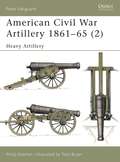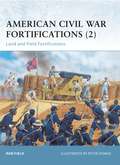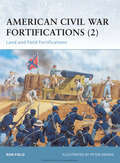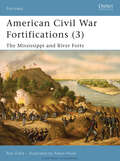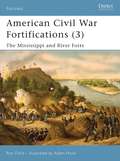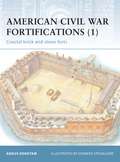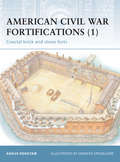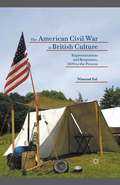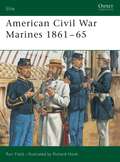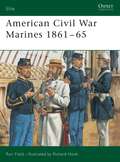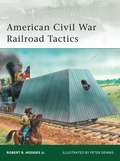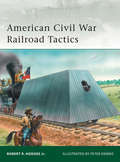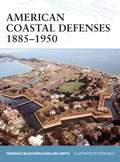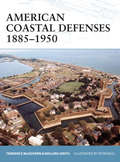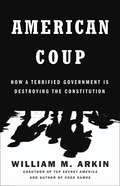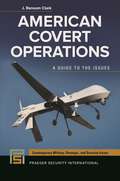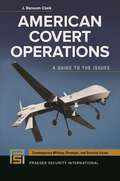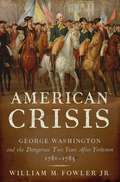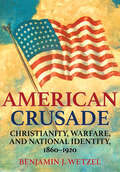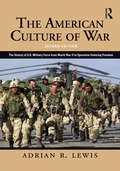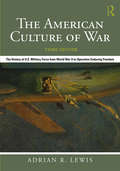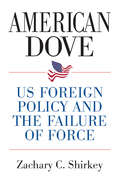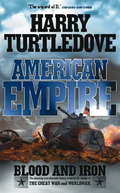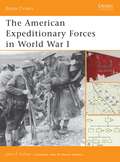- Table View
- List View
American Civil War Artillery 1861–65: Heavy Artillery (New Vanguard)
by Tony Bryan Philip KatcherBecause of the length of the coastline of the United States, from the beginning American ordnance and engineers placed an emphasis on heavy artillery mounted in coastal defences. The Union army organised its 'Heavy Artillery' into separate regiments, uniformed and equipped differently. While the Field Artillery was assigned across the fighting fronts Heavy Artillery units served the big guns in the forts and the defences of Washington. The Confederates did not differentiate types of artillery and those that became known as Heavy Artillery did so through informal association rather than formal designation. This book details the development and usage of the big guns. New Vanguard 38 and 40 are also available in a single volume special edition as 'American Civil War Artillery 1861-65'.
American Civil War Fortifications: Land and Field Fortifications (Fortress #2)
by Peter Dennis Ron FieldThe American Civil War saw a massive development in the use of field fortifications, the result of the practical application of antebellum West-Point teaching, and the deadly impact of rifled infantry weapons and artillery. Both the Federal and Confederate armies began to develop far more sophisticated systems of field fortification, and the larger field works and fortifications surrounding Washington, DC and Richmond, VA were redesigned and rebuilt several times. This volume explores the role of land and field fortifications in the eastern and overland campaigns of the Civil War between 1861 and 1865. Particular attention is devoted to the nine-month siege of Petersburg, where daily life within the redoubts, lunettes, redans, bomb-proofs, trenches and rifle pits is vividly described.
American Civil War Fortifications: Land and Field Fortifications (Fortress #38)
by Peter Dennis Ron FieldThe American Civil War saw a massive development in the use of field fortifications, the result of the practical application of antebellum West-Point teaching, and the deadly impact of rifled infantry weapons and artillery. Both the Federal and Confederate armies began to develop far more sophisticated systems of field fortification, and the larger field works and fortifications surrounding Washington, DC and Richmond, VA were redesigned and rebuilt several times. This volume explores the role of land and field fortifications in the eastern and overland campaigns of the Civil War between 1861 and 1865. Particular attention is devoted to the nine-month siege of Petersburg, where daily life within the redoubts, lunettes, redans, bomb-proofs, trenches and rifle pits is vividly described.
American Civil War Fortifications: The Mississippi and River Forts (Fortress #68)
by Ron FieldThe Mississippi River played a decisive role in the American Civil War. The Confederate fortifications that controlled the lower Mississippi valley were put to the test in the lengthy Federal campaign of 1862-63. Vicksburg was a fortress city, known as the 'Gibraltar of the Confederacy', whose capture was seen as the key to victory in the war. This book explores the fortifications of the river valley, focusing on Vicksburg and its defences which boasted a network of forts, rifle pits and cannon embrasures surrounding the city, a well as examining the strengths and weaknesses of the fortifications when under siege. Also examined are numerous other fortified strongholds, including New Orleans, Port Hudson, New Madrid, and forts Henry and Donelson, all lavishly illustrated with full-colour artwork and cutaways.
American Civil War Fortifications: The Mississippi and River Forts (Fortress #68)
by Adam Hook Ron FieldThe Mississippi River played a decisive role in the American Civil War. The Confederate fortifications that controlled the lower Mississippi valley were put to the test in the lengthy Federal campaign of 1862-63. Vicksburg was a fortress city, known as the 'Gibraltar of the Confederacy', whose capture was seen as the key to victory in the war. This book explores the fortifications of the river valley, focusing on Vicksburg and its defences which boasted a network of forts, rifle pits and cannon embrasures surrounding the city, a well as examining the strengths and weaknesses of the fortifications when under siege. Also examined are numerous other fortified strongholds, including New Orleans, Port Hudson, New Madrid, and forts Henry and Donelson, all lavishly illustrated with full-colour artwork and cutaways.
American Civil War Fortifications: Coastal Brick and Stone Forts (Fortress #6)
by Angus Konstam Donato SpedaliereThe 50 years before the American Civil War saw a boom in the construction of coastal forts in the United States of America. These stone and brick forts stretched from New England to the Florida Keys, and as far as the Mississippi River. At the start of the war some were located in the secessionist states, and many fell into Confederate hands. Although a handful of key sites stayed in Union hands throughout the war, the remainder had to be won back through bombardment or assault. This book examines the design, construction and operational history of those fortifications, such as Fort Sumter, Fort Morgan and Fort Pulaski, which played a crucial part in the course of the Civil War.
American Civil War Fortifications: Coastal brick and stone forts (Fortress)
by Angus Konstam Donato SpedaliereThe 50 years before the American Civil War saw a boom in the construction of coastal forts in the United States of America. These stone and brick forts stretched from New England to the Florida Keys, and as far as the Mississippi River. At the start of the war some were located in the secessionist states, and many fell into Confederate hands. Although a handful of key sites stayed in Union hands throughout the war, the remainder had to be won back through bombardment or assault. This book examines the design, construction and operational history of those fortifications, such as Fort Sumter, Fort Morgan and Fort Pulaski, which played a crucial part in the course of the Civil War.
The American Civil War in British Culture: Representations and Responses, 1870 to the Present
by Nimrod TalThis book explores the continuous British fascination with the American Civil War from the 1870s to the present. Analysing the War's place in British political discourse, military writing, intellectual life and popular culture, it traces the sources of Britons' appeal to the American conflict and their use of its representations at home and abroad.
American Civil War Marines 1861–65 (Elite)
by Ron Field Richard HookThe part played in the Civil War by the small Marine Corps of the United and Confederate States is overshadowed by the confrontations of the great armies. Nevertheless, the coastal and riverine campaigns were of real importance, given the strategic significance of the Federal blockade of southern ports, and of the struggle for the Mississippi River. Marines wearing blue and grey fought in many dramatic actions afloat and ashore – ship-to-ship engagements, cutting-out expeditions, and coastal landings. This book offers a comprehensive summary of all such battles, illustrated with rare early photographs, and meticulously researched color plates detailing the often obscure minutiae of Marine uniforms and equipment.
American Civil War Marines 1861–65 (Elite #112)
by Ron Field Richard HookThe part played in the Civil War by the small Marine Corps of the United and Confederate States is overshadowed by the confrontations of the great armies. Nevertheless, the coastal and riverine campaigns were of real importance, given the strategic significance of the Federal blockade of southern ports, and of the struggle for the Mississippi River. Marines wearing blue and grey fought in many dramatic actions afloat and ashore – ship-to-ship engagements, cutting-out expeditions, and coastal landings. This book offers a comprehensive summary of all such battles, illustrated with rare early photographs, and meticulously researched color plates detailing the often obscure minutiae of Marine uniforms and equipment.
American Civil War Railroad Tactics (Elite)
by Peter Dennis Robert R. Hodges Jr.The American Civil War was the world's first full-blown 'railroad war'. The well-developed network in the North was of great importance in serving the Union armies' logistic needs over long distances, and the sparser resources of the South were proportionately even more important. Both sides invested great efforts in raiding and wrecking enemy railroads and defending and repairing their own, and battles often revolved around strategic rail junctions. Robert Hodges reveals the thrilling chases and pitched battles that made the railroad so dangerous and resulted in a surprisingly high casualty rate. He describes the equipment and tactics used by both sides and the vital supporting elements – maintenance works, telegraph lines, fuel and water supplies, as well as garrisoned blockhouses to protect key points. Full-colour illustrations bring the fast-paced action to life in this fascinating read; a must-have volume for rail and Civil War enthusiasts.
American Civil War Railroad Tactics (Elite #171)
by Peter Dennis Robert R. Hodges Jr.The American Civil War was the world's first full-blown 'railroad war'. The well-developed network in the North was of great importance in serving the Union armies' logistic needs over long distances, and the sparser resources of the South were proportionately even more important. Both sides invested great efforts in raiding and wrecking enemy railroads and defending and repairing their own, and battles often revolved around strategic rail junctions. Robert Hodges reveals the thrilling chases and pitched battles that made the railroad so dangerous and resulted in a surprisingly high casualty rate. He describes the equipment and tactics used by both sides and the vital supporting elements – maintenance works, telegraph lines, fuel and water supplies, as well as garrisoned blockhouses to protect key points. Full-colour illustrations bring the fast-paced action to life in this fascinating read; a must-have volume for rail and Civil War enthusiasts.
American Coastal Defenses 1885–1950 (Fortress)
by Peter Bull Terrance McGovern Bolling SmithIn the late-19th century, with the advances in technology and the increase in America's economic stature, a new round of fortification building began in the United States and its overseas territories. Locations such as Portland, Boston, New York, Baltimore, Charlestown, Savannah, Key West, Los Angeles and San Francisco were all extensively fortified. This book provides a concise introduction to the design, development and purpose of American coastal defenses in the "modern" era (1885–1950), a period defined by the use of concrete, steel, and powerful breech-loading rifles. It covers the emplacements, weaponry, equipment, and people that defended their country in times of great change and uncertainty.
American Coastal Defenses 1885–1950 (Fortress #44)
by Peter Bull Terrance McGovern Bolling SmithIn the late-19th century, with the advances in technology and the increase in America's economic stature, a new round of fortification building began in the United States and its overseas territories. Locations such as Portland, Boston, New York, Baltimore, Charlestown, Savannah, Key West, Los Angeles and San Francisco were all extensively fortified. This book provides a concise introduction to the design, development and purpose of American coastal defenses in the "modern" era (1885–1950), a period defined by the use of concrete, steel, and powerful breech-loading rifles. It covers the emplacements, weaponry, equipment, and people that defended their country in times of great change and uncertainty.
American Coup: How a Terrified Government Is Destroying the Constitution
by William M. ArkinA stunning exploration of the subtle erosion of freedom in an age of concocted fear and de facto military authority. When we think of a military coup, the first image that comes to mind is a general, standing at a podium with a flag behind him, declaring the deposing of elected leaders and the institution of martial law. Think again. In American Coup, William Arkin reveals the desk-bound takeover of the highest reaches of government by a coterie of "grey men" of the national security establishment. Operating between the lines of the Constitution, this powerful and unelected group fights to save the nation from "terror" and weapons of mass destruction while at the same time modifying and undermining the very essence of the country. Many books are written about secrecy, surveillance, and government law-breaking; none so powerfully expose the truth of everyday life in this state of war.
American Covert Operations: A Guide to the Issues (Contemporary Military, Strategic, and Security Issues)
by J. Ransom ClarkTraces our country's long history of covert and special operations, focusing on the similarities and differences in the practice from the Revolutionary War to the present.Long before the creation of the CIA, the American government utilized special intelligence strategies with varying degrees of success. Even though critics throughout time have questioned the effectiveness and legitimacy of these tactics, presidents from George Washington to Barack Obama have employed secret operations to benefit the nation's best interest. This book follows America's history of intelligence gathering, undercover operations, and irregular warfare. Through chronologically organized chapters, the author examines secret military maneuvers, highlighting the elements common to covert and special operations across historical eras, and concluding with a chapter on national security since the attacks of September 11, 2001.
American Covert Operations: A Guide to the Issues (Contemporary Military, Strategic, and Security Issues)
by J. Ransom ClarkTraces our country's long history of covert and special operations, focusing on the similarities and differences in the practice from the Revolutionary War to the present.Long before the creation of the CIA, the American government utilized special intelligence strategies with varying degrees of success. Even though critics throughout time have questioned the effectiveness and legitimacy of these tactics, presidents from George Washington to Barack Obama have employed secret operations to benefit the nation's best interest. This book follows America's history of intelligence gathering, undercover operations, and irregular warfare. Through chronologically organized chapters, the author examines secret military maneuvers, highlighting the elements common to covert and special operations across historical eras, and concluding with a chapter on national security since the attacks of September 11, 2001.
American Crisis: George Washington and the Dangerous Two Years After Yorktown, 1781-1783
by William M. Fowler Jr.The story of the dramatic two years (October 1781-November 1783) after General Cornwallis's surrender at Yorktown, when the nascent United States was on the brink of immediate collapse.Most people believe the American Revolution ended in October, 1781, after the battle of Yorktown; in fact the war continued for two more traumatic years. During that time, the Revolution came closer to being lost than at any time in the previous half dozen. The British still held New York, Savannah, Wilmington, and Charleston; the Royal Navy controlled the seas; the states--despite having signed the Articles of Confederation earlier that year--retained their individual sovereignty and, largely bankrupt themselves, refused to send any money in the new nation's interest; members of Congress were in constant disagreement; and the Continental army was on the verge of mutiny.William Fowler's An American Crisis chronicles these tumultuous and dramatic two years, from Yorktown until the British left New York in November 1783. At their heart was the remarkable speech Gen. George Washington gave to his troops evcamped north of New York in Newburgh, quelling a brewing rebellion that could have overturned the nascent government.
American Crusade: Christianity, Warfare, and National Identity, 1860–1920
by Benjamin J. WetzelWhen is a war a holy crusade? And when does theology cause Christians to condemn violence? In American Crusade, Benjamin Wetzel argues that the Civil War, the Spanish-American War, and World War I shared a cultural meaning for white Protestant ministers in the United States, who considered each conflict to be a modern-day crusade. American Crusade examines the "holy war" mentality prevalent between 1860 and 1920, juxtaposing mainline Protestant support for these wars with more hesitant religious voices: Catholics, German-speaking Lutherans, and African American Methodists. The specific theologies and social locations of these more marginal denominations made their ministries highly critical of the crusading mentality. Religious understandings of the nation, both in support of and opposed to armed conflict, played a major role in such ideological contestation. Wetzel's book questions traditional periodizations and suggests that these three wars should be understood as a unit. Grappling with the views of America's religious leaders, supplemented by those of ordinary people, American Crusade provides a fresh way of understanding the three major American wars of the late nineteenth and early twentieth centuries.
The American Culture of War: A History of US Military Force from World War II to Operation Enduring Freedom
by Adrian R. LewisThe American Culture of War presents a sweeping, critical examination of every major American war of the late 20th century: World War II, Korea, Vietnam, the First and Second Persian Gulf Wars, through to Operation Enduring Freedom. Lewis deftly traces the evolution of US military strategy, offering an original and provocative look at the motives people and governments used to wage war, the debates among military personnel, the flawed political policies that guided military strategy, and the civilian perceptions that characterized each conflict. Now in its second edition, The American Culture of War has been completely revised and updated. New features include: Completely revised and updated chapters structured to facilitate students’ ability to compare conflicts New chapters on Operation Iraqi Freedom and the current conflict in Afghanistan New conclusion discussing the American culture of war and the future of warfare Over fifty maps, photographs, and images to help students visualize material Expanded companion website with additional pedagogical material for both students and researchers. The American Culture of War is a unique and invaluable survey of over seventy years of American military history, perfect for any student of America’s modern wars. For additional information and classroom resources please visit The American Culture of War companion website at www.routledge.com/cw/lewis.
The American Culture of War: The History of U.S. Military Force from World War II to Operation Enduring Freedom
by Adrian R. LewisNow in its third edition, The American Culture of War presents a sweeping critical examination of every major American war since 1941: World War II, Korea, Vietnam, the First and Second Persian Gulf Wars, U.S. operations in Iraq and Afghanistan, and the war against ISIS. As he carefully considers the cultural forces that surrounded each military engagement, Adrian Lewis offers an original and provocative look at the motives, people and governments used to wage war, the discord among military personnel, the flawed political policies that guided military strategy, and the civilian perceptions that characterized each conflict. This third edition features: A new structure focused more exclusively on the character and conduct of the wars themselves Updates to account for the latest, evolving scholarship on these conflicts An updated account of American military involvement in the Middle East, including the abrupt rise of ISIS The new edition of The American Culture of War remains a comprehensive and essential resource for any student of American wartime conduct.
The American Culture of War: The History of U.S. Military Force from World War II to Operation Enduring Freedom
by Adrian R. LewisNow in its third edition, The American Culture of War presents a sweeping critical examination of every major American war since 1941: World War II, Korea, Vietnam, the First and Second Persian Gulf Wars, U.S. operations in Iraq and Afghanistan, and the war against ISIS. As he carefully considers the cultural forces that surrounded each military engagement, Adrian Lewis offers an original and provocative look at the motives, people and governments used to wage war, the discord among military personnel, the flawed political policies that guided military strategy, and the civilian perceptions that characterized each conflict. This third edition features: A new structure focused more exclusively on the character and conduct of the wars themselves Updates to account for the latest, evolving scholarship on these conflicts An updated account of American military involvement in the Middle East, including the abrupt rise of ISIS The new edition of The American Culture of War remains a comprehensive and essential resource for any student of American wartime conduct.
American Dove: US Foreign Policy and the Failure of Force
by Zachary ShirkeyZachary C. Shirkey argues that the United States is overly reliant on the active use of force and should employ more peaceful foreign policy tools. Force often fails to achieve its desired ends for both tactical and strategic reasons and is relatively infungible, making it an inappropriate tool for many US foreign policy goals. Rather than relying on loose analogies or common sense as many books on US grand strategy do, American Dove bases its argument directly on an eclectic mix of academic literature, including realist, liberal, and constructivist theory as well as psychology. Shirkey also argues against retrenchment strategies, such as offshore balancing and strategic restraint as lacking a moral component that leaves them vulnerable to hawkish policies that employ moral arguments in favor of action. US withdrawal would weaken the existing liberal international security, economic, and legal orders—orders that benefit the United States. Rather, the book argues the United States needs an energetic foreign policy that employs passive uses of force such as deterrence and nonmilitary tools such as economic statecraft, international institutions, international law, and soft power. Such a policy leaves room for a moral component, which is necessary for mobilizing the American public and would uphold the existing international order. Last, Shirkey argues that to be successful, doves must frame their arguments in terms of strategy rather than in terms of costs and must show that dovish policies are consistent with national honor and a broad range of American values. American Dove offers a framework for US grand strategy and a plan for persuading the public to adopt it.
American Empire: Blood And Iron (Southern Victory: American Empire Ser. #1)
by Harry TurtledoveThe first volume of the American Empire trilogy from Harry Turtledove, "The Wizard of If".As Turtledove's brilliant series The Great War came to its end, the United States of America, in alliance with Germany, had defeated Great Britain, France and the Confederate States of America in a bloody conflict known as the First World War.Now as the 1920s begin, though, the seeds of a new conflict have already been sown. The United States, led by Theodore Roosevelt, swings wildly towards socialism. In Canada - now a US colony - nationalist terrorists strike against the new American oppressors. But it is in the Confederacy, trapped in a ruinous economic depression, where fascism begins to spread, and the fires are fanned by a charismatic leader who may again plunge the world into war.
The American Expeditionary Forces in World War I (Battle Orders #6)
by John VotawUpon the entry of the United States into World War I, the American Expeditionary Forces (AEF) were created by the War Department on short notice from existing units, filled up with men from the training camps and deployed with only their personal weapons and equipment. The US Army was not prepared for combat in France, and the remarkable achievement of the AEF's commanding officer, John J Pershing, was the creation of an American field army, built and nurtured from the bottom up. This book details the organizational structure, training and doctrine of the AEF and illustrates how it came to make a significant contribution to Allied victory in World War I.
